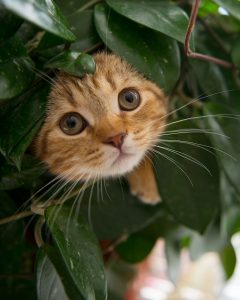Keeping Your Plant-Loving Pets Out of Danger
March 14, 2018

Looking to add a little greenery to brighten up your home and show your friends you’re “hip” to the hottest interior design trends (hint: interior jungles are hot)? Before you swipe your card at the local nursery on that designer fiddle leaf fig, giant cactus, or cut-leaf philodendron, remember that your cat or dog will also be living with, and possibly trying to ingest, your newest plant-child. We’ve done some research to help you choose plants that are safe for your furry family members!
Surprisingly, some of the most popular and easily available house plants are toxic to your pets. Ficus, snake plant (mother-in-law’s tongue), philodendron, and most cacti make this list, among many others.
Cats are usually the culprits when it comes to gnawing on indoor greenery. But dogs are at risk, too. Many of the same plants that can poison your cat can also poison your dog. With dogs, there’s also the risk that they will dig up and eat bulbs in your garden, and those can be poisonous, as well.
Toxic plants and signs and symptoms of poisoning
Aloe Vera – Toxic to cats and dogs if ingested, causing vomiting, diarrhea, depression, and tremors.
Snake Plant (Mother-in-Law’s Tongue) – Toxic to cats and dogs if ingested, causing nausea, vomiting, and diarrhea.
Philodendron – Toxic to cats and dogs if ingested; causing oral irritation, pain and swelling of the mouth, tongue and lips, excessive drooling, and difficulty swallowing.
Weeping Fig Tree – Toxic to cats and dogs, causing dermatitis from skin contact with the plant, and oral irritation, excessive drooling, and vomiting if ingested.
Fiddle Leaf Fig – Toxic to cats and dogs if ingested, causing oral irritation, excessive drooling, and vomiting.
Cactus – Hazardous to cats and dogs if touched.
Lilies – Most lily varieties pose a toxicity threat to your pet. While the allure of a freshly cut spring bouquet on your dining table is enchanting, your cat or dog might see it as more of a meal than a décor piece. Even a few nibbles of the leaves or flowers, or a whiff of the pollen in some varieties, can have fatal results for your pets.
While some lily varieties aren’t deadly (such as Peace and Calla), they can still cause moderate to severe poisoning symptoms in your pet. Symptoms include excessive drooling, vomiting, trouble swallowing, pawing at the mouth, lack of appetite, and mouth irritation.
Lilies such as Easter, Tiger, Day, Japanese, and Stargazer are of the kidney-failure inducing variety. Signs of poisoning include vomiting, loss of appetite, excessive drooling, lethargy, dehydration, excessive or decreased thirst and urination, abdominal pain, and kidney failure.
If think your pet consumed part of a poisonous plant, or you notice these symptoms, get your pet to a veterinarian immediately for treatment.
Pet-safe plants
So, what’s a pet and plant lover to do? There’s lots animal-safe plants out there that can add that trendy-leafy-jungle feeling to your décor!
Here are some lovely examples:
Majesty Palm – A large, indoor palm that likes 6-8 hours of bright light and moist soil.
Maidenhair Fern – Delicate and finicky, it thrives with constant moisture (not soggy) and indirect morning or afternoon light.
Spider Plant – Adaptable and easy to grow. Provide your spider plant with well-drained soil and bright indirect light and it will flourish.
Orchids – Strong, indirect light, high humidity, airflow around the roots, and alternating periods between drying soil and heavy watering is preferred to help an orchid bloom. This can vary depending on variety.
Staghorn Ferns – Commonly seen mounted on a piece of wood allowing for airflow around the roots. Bright indirect light, humidity, and constant, but not soggy, moisture help this epiphyte to thrive.
Bamboo – Fast growing, bamboo likes well-drained soil and plenty of water, and five hours of direct sunlight daily.
Cast Iron Plant – A member of the lily family, this plant isn’t toxic to your pet. Keep soil continuously moist and provide it with semi-shade to bright light. It does not like direct sunlight.
Bromeliad – A relative of the pineapple, bromeliads enjoy bright, but not direct, light and monthly watering.
Maybe you already have some of the toxic plants listed and your pets comingle without a problem. Or maybe you just don’t have the heart to adopt out your cacti collection even though your pets are curious about them. One technique for distracting your pets away from the potential danger is to grow pet grass. Once mature, place the grass near your pet’s food bowl and reinforce positive behavior. A pet herb garden is another option, with the thinking being that some pets will instinctively eat herbs that have medicinal value, such as a peppermint to settle an upset tummy.
Another option is buying a pet-safe, bitter tasting plant spray to deter them from nibbling.
Not sure if your house plants are pet safe? The ASPCA has a great online database of toxic and non-toxic plants that includes photos and potential signs of poisoning you should watch for. You can visit their website at www.aspca.org.



